生成一个连续数字的旋转二维数组,起始位置位于左上角,然后从起始位置开始递增,按照顺时针或者逆时针从外向里将连续的数组存入二维数组中,并输出生成的旋转二维数组。
测试代码:
输出结果:
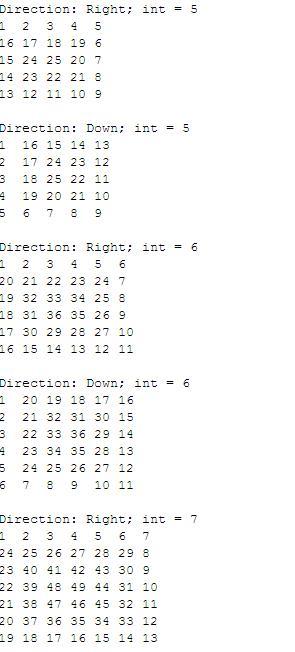
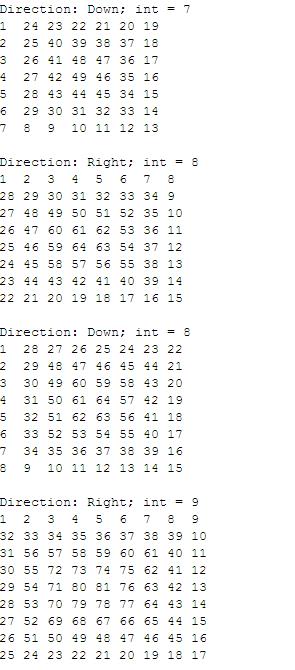
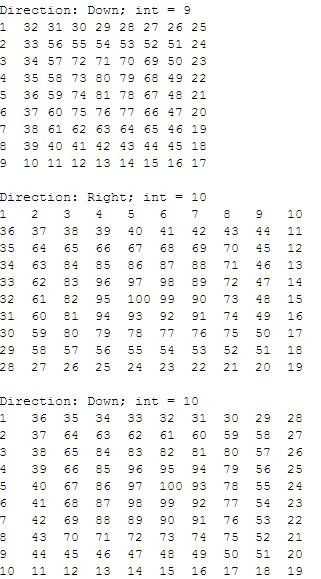
下面在显示一个大小为 34*34的旋转二维数组:
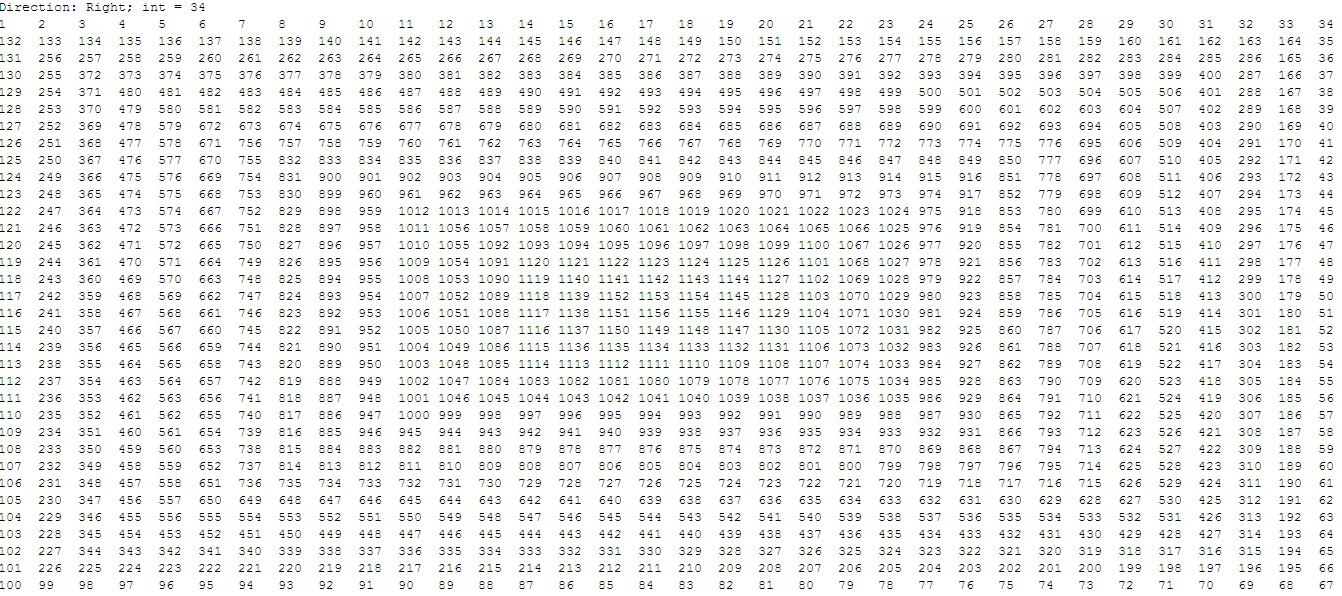
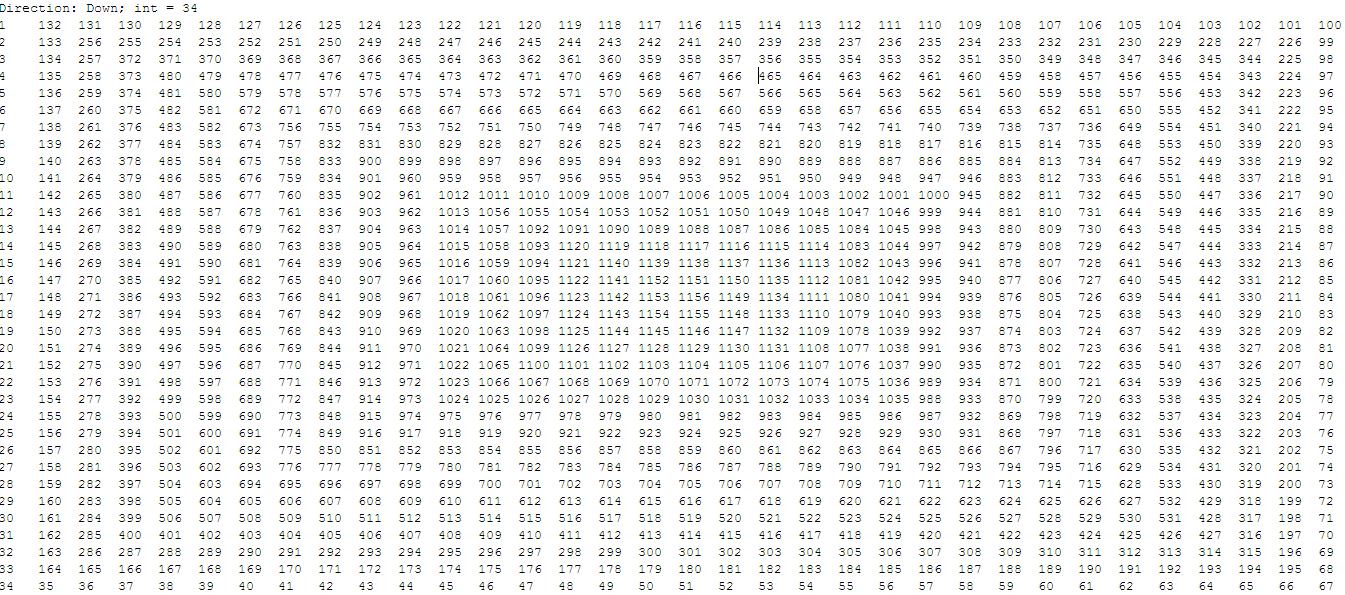
- /**
- *
- * <code>ConvolutionalArray</code>主要是用来输出一个旋转式样的二维数组。
- *
- *
- * 此二维数组由连续的数字组成,比如:
- * *
- * int i=5;
- * 1 2 3 4 5
- * 16 17 18 19 6
- * 15 24 25 20 7
- * 14 23 22 21 8
- * 13 12 11 10 9
- * int i=6
- * 1 2 3 4 5 6
- * 20 21 22 23 24 7
- * 19 32 33 34 25 8
- * 18 31 36 35 26 9
- * 17 30 29 28 27 10
- * 16 15 14 13 12 11
- *
- *
- * @author Eric
- * @version 1.0
- *
- */
- public class ConvolutionalArray {
- private static final int DEFAULT_NUMBER = 5;
- // 定义连续数字添加的方向
- private enum Direction {
- Right, Down, Left, Up;
- }
- // 保存当前处理的方向,默认一开始是向右的。
- private Direction currentDirection = Direction.Right;
- // 将一个二维数组看成X, Y两个方向,记录下,最小的X,Y值以及最大的X,Y
- private int minX = 0;
- private int minY = 0;
- private int maxX = DEFAULT_NUMBER - 1;
- private int maxY = DEFAULT_NUMBER - 1;
- private int currentCount = 0;
- /**
- * 打印数组。
- *
- * @param expectedNumber :
- * 期望的二维数组每行显示的个数。
- */
- public void printArray(int expectedNumber) {
- int[][] array = buildArray(expectedNumber);
- printArray(array, expectedNumber);
- }
- /**
- *
- * @param expectedNumber:
- * 期望的二维数组每行显示的个数。
- * @return: 返回一个连续数字组成的二维数组。
- */
- private int[][] buildArray(int expectedNumber) {
- int[][] result = new int[expectedNumber][expectedNumber];
- // Total number of numeric values
- int count = expectedNumber * expectedNumber;
- // Reset max value for maxX and maxY.
- maxY = expectedNumber - 1;
- maxX = expectedNumber - 1;
- /*
- * 如果要生成一个nxn的二维数组,那么里面的最大数应该是n*n, 当处理的数字还没有达到这个最大值,一直循环处理下去。
- *
- */
- while (currentCount < count) {
- /*
- * 因为开始默认的方向是Right,也就是顺时针方向,所以,处理的顺序是 Right -> Down -> Left -> Up
- * ->Right ... 每次一个方向填充值之后,需要先判断当前数据是否达到最大值。
- */
- if (currentCount < count) {
- processRight(result);
- }
- if (currentCount < count) {
- processDown(result);
- }
- if (currentCount < count) {
- processLeft(result);
- }
- if (currentCount < count) {
- processUp(result);
- }
- }
- return result;
- }
- /**
- * 向右方向填充数据。
- */
- private void processRight(int[][] currentArray) {
- for (int i = minX; i <= maxX; i++) {
- currentArray[minY][i] = ++currentCount;
- }
- changeDirection();
- minY++;
- }
- /**
- * 向下方向填充数据。
- */
- private void processDown(int[][] currentArray) {
- for (int i = minY; i <= maxY; i++) {
- currentArray[i][maxX] = ++currentCount;
- }
- changeDirection();
- maxX--;
- }
- /**
- * 向左方向填充数据。
- */
- private void processLeft(int[][] currentArray) {
- for (int i = maxX; i >= minX; i--) {
- currentArray[maxY][i] = ++currentCount;
- }
- changeDirection();
- maxY--;
- }
- /**
- * 向上方向填充数据。
- */
- private void processUp(int[][] currentArray) {
- for (int i = maxY; i >= minY; i--) {
- currentArray[i][minX] = ++currentCount;
- }
- changeDirection();
- minX++;
- }
- /**
- * 打印二维数组的内容。
- *
- * @param array
- * @param expectedNumber
- */
- private void printArray(int[][] array, int expectedNumber) {
- for (int i = 0; i < expectedNumber; i++) {
- for (int j = 0; j < expectedNumber; j++) {
- System.out.print(appendSpace(array[i][j], expectedNumber));
- }
- System.out.println();
- }
- }
- /**
- * 为了保证数据输出时能够对齐,添加一些空格.
- */
- private String appendSpace(int value, int expectedNumber) {
- int maxValue = expectedNumber * expectedNumber;
- int maxLength = String.valueOf(maxValue).length();
- int currentValueLength = String.valueOf(value).length();
- StringBuilder sb = new StringBuilder();
- sb.append(value);
- for (int i = maxLength; i > currentValueLength; i--) {
- sb.append(" ");
- }
- sb.append(" ");
- return sb.toString();
- }
- /**
- * 改变当前的方向。
- */
- private void changeDirection() {
- switch (currentDirection) {
- case Right:
- currentDirection = Direction.Down;
- break;
- case Down:
- currentDirection = Direction.Left;
- break;
- case Left:
- currentDirection = Direction.Up;
- break;
- case Up:
- currentDirection = Direction.Right;
- break;
- }
- }
- /**
- * 在一个二维数组基础上,以对角线为对称线,实现两侧数据的交换,并返回这个交换数据后的二维数组。
- *
- * 这样做有一个用处:比如已经有一个向右的二维旋转数组(向右):
- *
- 1 2 3 4
- 12 13 14 5
- 11 16 15 6
- 10 9 8 7
- 采用此方法之后,可以得到一个向下方向的二维旋转数组(向下)
- 1 12 11 10
- 2 13 16 9
- 3 14 15 8
- 4 5 6 7
- */
- private int[][] exchangeArray(int[][] originalArray, int expectedNumber) {
- int[][] exchangedArray = new int[expectedNumber][expectedNumber];
- for (int i = 0; i < expectedNumber; i++) {
- for (int j = 0; j < expectedNumber; j++) {
- exchangedArray[i][j] = originalArray[j][i];
- }
- }
- return exchangedArray;
- }
- /**
- * 打印交换数据后的二维数组。
- */
- public void printExchangedArray(int expectedNumber) {
- int[][] array = buildArray(expectedNumber);
- printArray(exchangeArray(array, expectedNumber), expectedNumber);
- }
- }
测试代码:
- public class Test {
- public static void main(String[] args) {
- for (int i = 5; i < 11; i++) {
- System.out.println("Direction: Right; int = " + i);
- new ConvolutionalArray().printArray(i);
- System.out.println();
- System.out.println("Direction: Down; int = " + i);
- new ConvolutionalArray().printExchangedArray(i);
- System.out.println();
- }
- }
- }
输出结果:



下面在显示一个大小为 34*34的旋转二维数组:



























 268
268

 被折叠的 条评论
为什么被折叠?
被折叠的 条评论
为什么被折叠?








